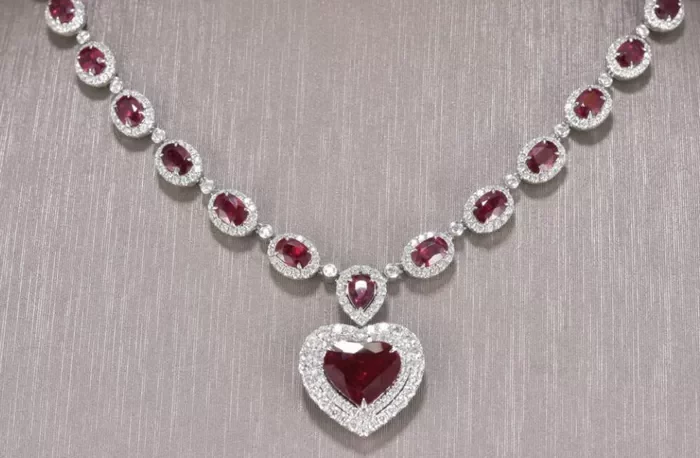Edwardian ruby rings are a testament to the enduring allure of this captivating gemstone. Crafted during the Edwardian era (1901-1910), these exquisite pieces of jewelry showcase the elegance and sophistication of the period while embodying the rich symbolism and mythology that has surrounded rubies for centuries. In this article, we will delve into the fascinating world of Edwardian ruby rings, exploring their history, symbolism, and the myths that have shaped their legacy.
The Edwardian Era: A Time of Elegance and Refinement
The Edwardian era, named after King Edward VII of the United Kingdom, was a period of unparalleled elegance, sophistication, and technological advancement. This era witnessed a shift in jewelry design, moving away from the heavy, ornate styles of the Victorian era towards a more delicate, lace-like aesthetic. Edwardian jewelry was characterized by intricate filigree work, delicate platinum settings, and the use of diamonds and pearls to create a sense of lightness and grace[1].
Ruby rings were no exception to this trend. Edwardian ruby rings often featured delicate, open-work settings that allowed the light to pass through the gemstone, enhancing its natural brilliance and fire. The use of platinum in these settings created a crisp, clean look that complemented the ruby’s deep red hue perfectly.
The Symbolism of Rubies in Edwardian Jewelry
Rubies have long been associated with passion, love, and power. In Edwardian times, this symbolism was particularly relevant, as ruby rings were often given as tokens of love and commitment. The deep red color of the ruby was believed to represent the intensity of the wearer’s emotions, making it the perfect choice for engagement and wedding rings.
In addition to their romantic symbolism, rubies were also believed to possess protective powers. It was thought that wearing a ruby ring could ward off evil spirits and bring good fortune to the wearer. This belief was particularly prevalent among the upper classes, who often commissioned custom-made ruby rings to serve as talismans and amulets.
Edwardian Ruby Rings in Popular Culture
Edwardian ruby rings have long captured the imagination of the public, appearing in literature, film, and popular culture. One of the most famous examples is the “Heart of the Ocean” necklace from the 1997 film Titanic. Although the necklace itself was fictional, it was inspired by the famous Hope Diamond and featured a large, heart-shaped blue diamond surrounded by smaller rubies.
Another notable example is the “Wallis Simpson Ruby Ring,” a stunning ruby and diamond ring that once belonged to the Duchess of Windsor. The ring features a large, oval-shaped ruby surrounded by diamonds in a platinum setting and is considered one of the most valuable and iconic pieces of Edwardian jewelry in existence.
See Also: All You Need To Know About Ruby Vintage Engagement Rings
Myths and Legends Surrounding Edwardian Ruby Rings
Like many precious gemstones, rubies have been the subject of numerous myths and legends throughout history. In Edwardian times, these myths and legends continued to shape the public’s perception of ruby rings.
One of the most persistent myths surrounding rubies is their ability to ward off evil spirits and bring good fortune to the wearer. It was believed that a ruby ring could protect its wearer from harm and ensure a long and prosperous life. This belief was particularly prevalent among the upper classes, who often commissioned custom-made ruby rings to serve as talismans and amulets.
Another myth surrounding rubies is their ability to reveal the truth. It was believed that a ruby ring could change color if the wearer was being dishonest or unfaithful. This myth likely contributed to the popularity of ruby rings as engagement and wedding rings, as they were seen as a way to ensure the fidelity and loyalty of the wearer.
The Enduring Appeal of Edwardian Ruby Rings
Despite the passage of time, Edwardian ruby rings continue to captivate and inspire. Their elegant, timeless design and rich symbolism have made them a perennial favorite among collectors and jewelry enthusiasts alike.
Today, Edwardian ruby rings are highly sought after by collectors and museums, with some pieces fetching millions of dollars at auction. The “Wallis Simpson Ruby Ring,” for example, sold for a record-breaking $4.2 million at a Sotheby’s auction in 2021.
The enduring appeal of Edwardian ruby rings can be attributed to their unique blend of elegance, symbolism, and historical significance. These rings serve as a tangible link to a bygone era, a time of opulence, refinement, and romantic ideals. By wearing an Edwardian ruby ring, one can feel connected to the rich history and mythology that has surrounded these captivating gemstones for centuries.
Conclusion
Edwardian ruby rings are a testament to the enduring allure of this captivating gemstone. Crafted during a period of unparalleled elegance and sophistication, these exquisite pieces of jewelry embody the rich symbolism and mythology that has surrounded rubies for centuries. From their delicate, open-work settings to their deep red hue, Edwardian ruby rings continue to captivate and inspire, serving as a tangible link to a bygone era and a symbol of passion, love, and power.
Whether you are a collector, a jewelry enthusiast, or simply someone who appreciates the beauty and history of these remarkable gemstones, Edwardian ruby rings are sure to capture your imagination and leave a lasting impression. So why not explore the fascinating world of Edwardian ruby rings for yourself and discover the magic and mystery that lies within?


